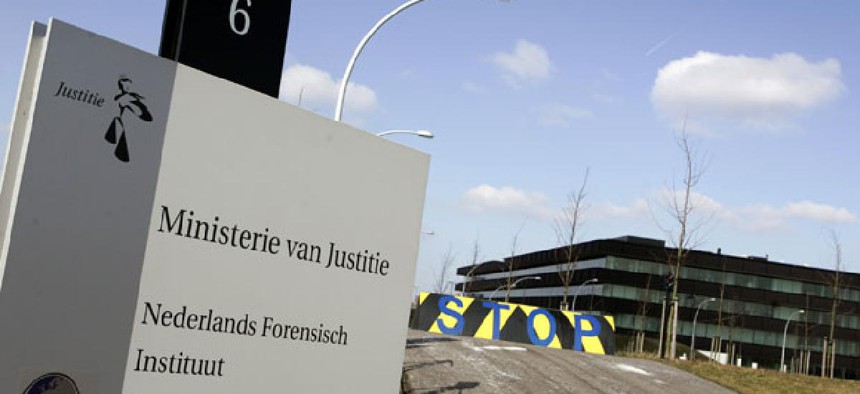Should feds adopt a DNA program that cracked a 1999 Dutch murder case?

The Netherlands Forensic Institute building is in The Hague. AP file photo
Independent agency could help police expand DNA use. Privacy advocates balk.
The National Academy of Sciences unsuccessfully recommended the federal government establish an independent agency for advancing forensic science similar to one in the Netherlands that recently helped authorities conduct a DNA sweep to nab a rapist who in 1999 murdered a 16-year-old.
an academy report.Across the Atlantic, the Dutch have created such an entity in the form of the Netherlands Forensic Institute, a nonprofit, government-owned agency. Officials at the organization, which is not part of the country’s police or prosecution office, say the institute is neutral on questions of guilt or innocence and offers services to politicians, the media and competitors.
“They’ve invested significantly in modern technology, and they have prioritized filling vacancies” with new hires, said Tom O’Reilly, a former U.S. Justice official who invited one of the institute’s leaders to speak at Rutgers University, where O’Reilly now serves as executive director of the Police Institute.
In October 2012, following a recent change in Netherlands law to allow mass DNA screenings, Dutch government officials invited more than 8,000 men to contribute DNA so that police could locate relatives of whoever killed 16-year-old Marianne Vaatstra, according to institute officials.
Investigators believed the killer might have lived close to the crime scene. A man’s DNA was found there on a locally-bought cigarette lighter but no match existed in the Netherlands’ national DNA database of offenders. “They decided to screen the DNA of all males who, in 1999, were aged between 16 and 60 and lived nearby,” the institute’s website states.
The episode might have been the biggest familial DNA search carried out worldwide, according to the institute. The Amsterdam Herald reported the perpetrator, who was arrested in November, was a direct match, meaning he was one of the throng of men who showed up to submit DNA.
The average analysis time at the institute, founded in 1999, is among the fastest in the world, according to Netherlands officials. Typically, the turnaround period is slightly less than two weeks. A priority crime-scene case, involving processing and comparisons, is guaranteed for delivery within six hours, but usually arrives within 3.5 hours.
By contrast, Justice officials said processing times in the United States vary, depending on other factors including the type of case -- a homicide or rape might be processed ahead of a property crime -- whether the case is pending trial, and the number of backlogged cases. The Dutch institute has no backlog.
For the violent rape case, the Netherlands institute used a tool called Bonaparte developed in cooperation with the Radboud University Nijmegen. The automated technology relies on mathematical “probabilistic methods” to quickly and accurately find one-to-one matches and “pedigree matches,” or familial connections derived from partial and full family trees, according to agency literature.
U.S. citizens might not want to volunteer for ‘DNA dragnets’
Privacy concerns stateside might have scuttled this kind of plan before the invitations ever went out.
“DNA dragnets – that’s pretty much unheard of,” said Kelly Walsh, a researcher with the Justice Policy Center at the Urban Institute, a nonprofit think tank. She added that such activities are rare, not necessarily because America lacks the technical foundations, but rather Justice faces a "constant tradeoff between protecting civil liberties and how quickly you can implement new technology.”
Some civil liberties advocates agreed that catching offenders through DNA lineups would not go over well in the United States.
“The idea that the government would coerce people to submit their DNA. . . It doesn’t seem like solving that one crime justifies collecting DNA from all those people,” said Jennifer Lynch, staff attorney for the Electronic Frontier Foundation, a privacy group. “It’s not just the individual person whose privacy is implicated but also that person’s family members. There’s always the issue of what happens to that DNA after the fact.” At least in America, there are worries that stored DNA may be reused for separate purposes, such as solving future criminal cases, determining insurance costs or denying employment.
Officials for the Netherlands institute said the samples collected for the 1999 murder case would only be used for that investigation and destroyed afterwards.
Unlike Justice’s congressionally funded National Institute of Justice, which finances stateside DNA research and development, the Netherlands institute supports itself by charging Dutch and international organizations for technology and services. The independent agency conducts forensic investigations, like most forensic labs, but also has the freedom and funding to act as an entrepreneur.
“Research and development, in order to create innovative proprietary products and services, is one of the main activities of the NFI,” said Tjark Tjin-A-Tsoi, chief executive officer of the Netherlands Forensic Institute.
The country used the same Bonaparte software to identify all 103 fatalities in a 2001 Afriqiyah Airways crash in Tripoli -- within three weeks. The United States can identify victims of disasters within an equivalent amount of time, using different technology, according to Justice statistics. In 2001, it took less than two months to identify the 265 casualties of an American Airlines crash in Queens, N.Y., partly because the groundwork for analyzing mass remains had been laid months earlier, during the Sept. 11 terrorist attacks.
Justice uses software it developed called CODIS to name missing persons and disaster victims, according to FBI officials. The same technology allows crime laboratories nationwide to store and compare DNA records. FBI officials noted that the Netherlands Forensic Institute currently uses CODIS to operate the Netherlands’ national DNA database of offenders. Although bureau officials have seen a demonstration of Bonaparte, they said CODIS’ ability to identify individuals meets the FBI’s needs.
National Institute of Justice and FBI officials declined to comment on the academy’s recommendation that the government relocate research and development to an independent forensic science agency.



